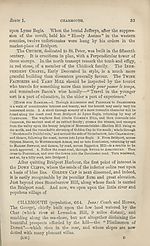Download files
Complete book:
Individual page:
Thumbnail gallery: Grid view | List view

32
FROM POOLE TO LYME REGIS.
Route 1.
each end of the Quay shoots out a rude wooden pier, and between
the two lie the small craft connected with the port.
BRIDPORT—the Harbour of the Bride, or Bredy.
[Population, 4653. Inns: Bull, Greyhound, and, near the Quay, the George.
18 m., by rail, from Dorchester; 135 m. from London ; 21 m., by road, from
Weymouth ; 10 m. from Abbotsbury Castle ; 8} m. from Beauminster; 9J m. from
Lyme Regis; 8 m. from Stoke Abbas ; 6 m. from Whitechurch ; 10 m. from Winford
<3T Coaches daily to Charmouth, Lyme Regis, Weymouth, and Dorchester.
Bankers : Messrs T. H. Williams & Co.—Markets, Wednesday and Saturday.]
The configuration of the town of Bridport is easily described.
Fancy a gentle ascent, sloping towards the sea on the south, and
down into a small valley on the east and west. From these
valleys let bold hills arise, and throw out an amphitheatre of hills
towards the north. Imagine one long, broad thoroughfare run¬
ning up and down the ascent, from east to west, and, of course,
commanding either way a pleasant prospect of a fresh, green hill
—especially, to the westward, of Colmer’s Hill, which has
always a strangely picturesque appearance. Out of the network
of streets, which makes up Bridport proper, starts a wide and
sinuous street—they say it is a mile and a half long—crossing
the lowlands to the sea-shore, where it terminates at a busy quay,
and where a small hamlet is devoted to fishermen, boatmen, and
their “ belongings.”
The principal manufactures are those of twine, shoe-thread,
and rope. In Henry VIH.’s time, most of the cordage used in
the royal navy was fabricated here, or within a circle of five miles.
From the hemp grown largely in the neighbourhood came the
phrase—to be “ stabbed with a Bridport dagger,”—i.e., to be
hung.
Bridport has no history. It returns, and has long returned,
two members to Parliament, and possibly its electioneering annals
might afford some half-dozen skirmishes or riots if it were worth
one’s while to burrow for them; but its historical associations, in
a wider sense, are really insignificant. It was implicated, with
almost all the western towns, in Monmouth’s rebellion, and it was
here that Grey and Wade, on the 14th of June, 1685, attacked
the red regiment of the Dorsetshire militia. They were com¬
pelled, however, to retreat—with little honour to themselves—
FROM POOLE TO LYME REGIS.
Route 1.
each end of the Quay shoots out a rude wooden pier, and between
the two lie the small craft connected with the port.
BRIDPORT—the Harbour of the Bride, or Bredy.
[Population, 4653. Inns: Bull, Greyhound, and, near the Quay, the George.
18 m., by rail, from Dorchester; 135 m. from London ; 21 m., by road, from
Weymouth ; 10 m. from Abbotsbury Castle ; 8} m. from Beauminster; 9J m. from
Lyme Regis; 8 m. from Stoke Abbas ; 6 m. from Whitechurch ; 10 m. from Winford
<3T Coaches daily to Charmouth, Lyme Regis, Weymouth, and Dorchester.
Bankers : Messrs T. H. Williams & Co.—Markets, Wednesday and Saturday.]
The configuration of the town of Bridport is easily described.
Fancy a gentle ascent, sloping towards the sea on the south, and
down into a small valley on the east and west. From these
valleys let bold hills arise, and throw out an amphitheatre of hills
towards the north. Imagine one long, broad thoroughfare run¬
ning up and down the ascent, from east to west, and, of course,
commanding either way a pleasant prospect of a fresh, green hill
—especially, to the westward, of Colmer’s Hill, which has
always a strangely picturesque appearance. Out of the network
of streets, which makes up Bridport proper, starts a wide and
sinuous street—they say it is a mile and a half long—crossing
the lowlands to the sea-shore, where it terminates at a busy quay,
and where a small hamlet is devoted to fishermen, boatmen, and
their “ belongings.”
The principal manufactures are those of twine, shoe-thread,
and rope. In Henry VIH.’s time, most of the cordage used in
the royal navy was fabricated here, or within a circle of five miles.
From the hemp grown largely in the neighbourhood came the
phrase—to be “ stabbed with a Bridport dagger,”—i.e., to be
hung.
Bridport has no history. It returns, and has long returned,
two members to Parliament, and possibly its electioneering annals
might afford some half-dozen skirmishes or riots if it were worth
one’s while to burrow for them; but its historical associations, in
a wider sense, are really insignificant. It was implicated, with
almost all the western towns, in Monmouth’s rebellion, and it was
here that Grey and Wade, on the 14th of June, 1685, attacked
the red regiment of the Dorsetshire militia. They were com¬
pelled, however, to retreat—with little honour to themselves—
Set display mode to:
![]() Universal Viewer |
Universal Viewer | ![]() Mirador |
Large image | Transcription
Mirador |
Large image | Transcription
| Antiquarian books of Scotland > Adventure and adventurers > Black's guide to Dorsetshire > (48) |
|---|
| Permanent URL | https://digital.nls.uk/116814488 |
|---|
| Description | Thousands of printed books from the Antiquarian Books of Scotland collection which dates from 1641 to the 1980s. The collection consists of 14,800 books which were published in Scotland or have a Scottish connection, e.g. through the author, printer or owner. Subjects covered include sport, education, diseases, adventure, occupations, Jacobites, politics and religion. Among the 29 languages represented are English, Gaelic, Italian, French, Russian and Swedish. |
|---|

